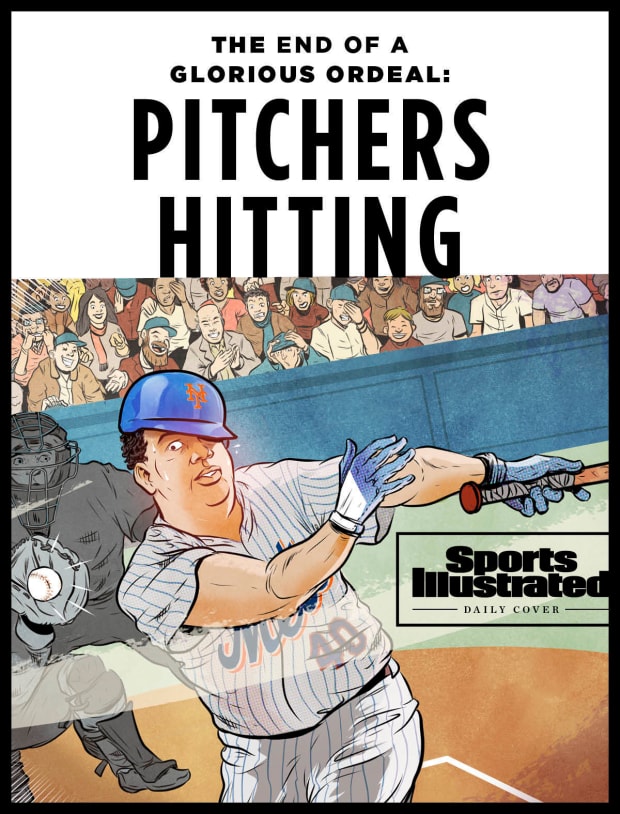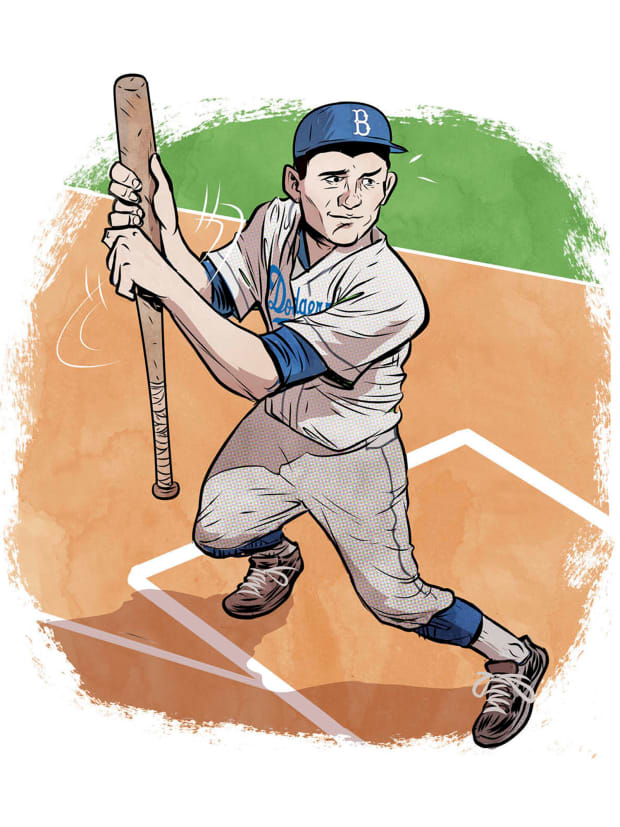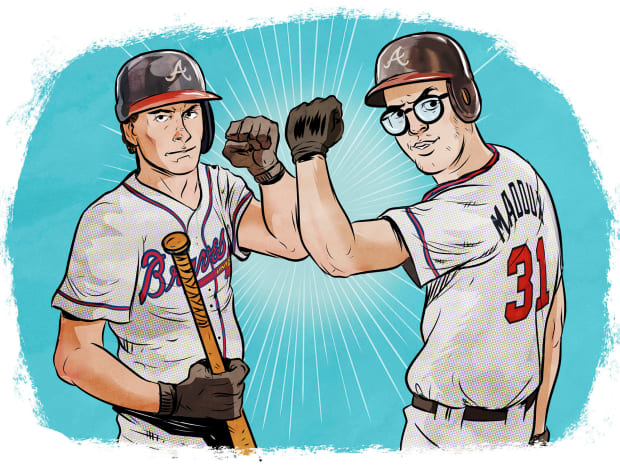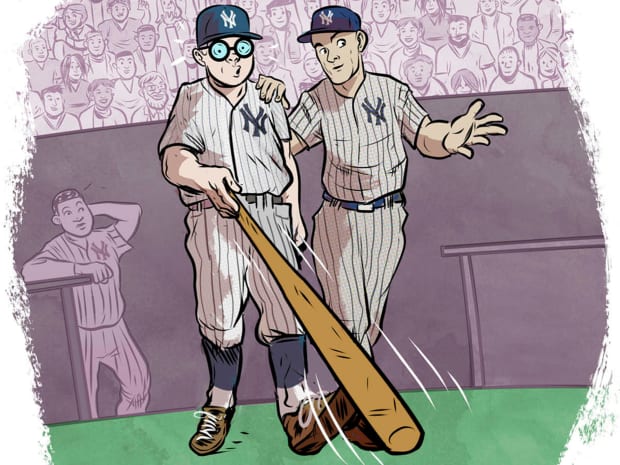An ode to MLB's free swingers, non-swingers and jacket-wearing runners.
In the grillroom of McArthur Golf Club in Hobe Sound, Fla., this winter, two retired pitchers were talking baseball. Jim Kaat pitched 25 seasons in the big leagues, in four decades, for six teams, while one-time Phillies prospect Bill Parcells topped out as a teenager in New Jersey, only to become a football coach of some renown. Still, both men fondly recalled the oversize sweats—some were feed bags fashioned into baseball pants—they wore to practice sliding in the 1950s should they ever have to leg out a double. “We wanted to be baseball players, not pitchers,” says Kaat, 82. “We wanted to learn to bunt, slide, run the bases and help ourselves out with the bat.”
Major league pitchers have been batting for 150 years now. Their walk-up music, in the mind’s ear, is “Entry of the Gladiators,” the theme of the Ringling Bros. and Barnum & Bailey Circus, for pitchers have often looked silly at the plate. Last season they laid down their weapons entirely when the National League used designated hitters, as the American League has done since 1973. Pitchers are unlikely to bat at all in 2022, when the universal DH is expected to be enshrined permanently in a new collective bargaining agreement. That leaves 2021 as their final trip around the bases, a valedictory lap for men who tend to run awkwardly, wearing warmup jackets, after reaching on an error, or a dropped third strike, or some form of suspected chicanery. In 1964 the severely nearsighted Reds pitcher Ryne Duren was accused by the Cardinals of thrusting his knee into a pitch to reach first base. It was more useful than his bat. As one writer put it, “[Duren] couldn’t hit the ground with a safe.”

If this is the obituary for pitchers as batters, there are multiple causes of death, including asphyxiation. With every inelegant swing, Brooklyn pitcher Preacher Roe choked up a little higher on the bat, his hands slowly climbing the barrel like a koala ascending a eucalyptus trunk. Deep into a count, Roe risked having more lumber below his fists than above them. He was so lost at the plate that the left-handed pitcher tried switch-whiffing. “Roe often would take two strikes hitting right-handed, then finish the strikeout left-handed,” his Dodgers teammate Pete Reiser told a reporter after Roe retired in 1954 with 215 strikeouts in 620 at bats. “Anything to try to change his luck.”
Roe wasn’t unlucky as a hitter. He was un-good. Most pitchers are. A difficult enough task for everyday players, hitting is infinitely more challenging for anyone attempting to do it every fourth or fifth day. “When the other players on the club are taking their licks in batting practice, the pitchers are sprinkled around in the outfield and delegated to chase fly balls,” noted Los Angeles Times baseball writer and foreign correspondent Harry A. Williams. “Chasing balls for other people is not calculated to benefit a man’s batting eye.”
That was in 1913, after which a few pitchers did do significant damage with a bat. Babe Ruth used to make an annual bet with Yankees pitcher Lefty Gomez that Gomez wouldn’t get five hits on the season, a wager Gomez usually ended up winning, by a narrow margin, in late September. One afternoon Ruth handed Gomez his own bat and told him to a hit a home run with it. While attempting to knock the dirt from his spikes in the on-deck circle, Gomez smashed himself in the ankle instead and had to be hospitalized. But at least he hit something. At least he held something—that Ruthian Louisville Slugger, full of latent energy. Some pitchers couldn’t be bothered schlepping 42 ounces to the plate.

On April 2, 1982, A’s righthander Steve McCatty approached the batter’s box in Yuma, Ariz., in the final week of spring training. Oakland manager Billy Martin didn’t want his ace to risk injury by swinging—or God forbid, to get a hit and have to run the bases—so McCatty strode to the plate with a 15-inch bat, purchased that night at the souvenir stand, an effort umpire Jim Quick found humorous but beneath the dignity of even a Cactus League game. A batboy brought McCatty some real lumber, which Cat left on his shoulder as he watched three pitches sail by. Quick, quickly, punched him out.
“In my opinion, there is nothing as dull in baseball as watching pitchers try to hit,” said Hall of Fame first baseman George Sisler, who played during the Warren G. Harding Administration, by which time it was already long-established that pitchers—like the anti–Venus de Milo—were valued for only their arms. “A pitcher isn’t expected to hit, and he knows it,” Tigers pitcher Bill Donovan said in 1908. “Therefore, he doesn’t pay attention to that end of the game.”
As a rookie with the Phillies in 1980, Bob Walk wasn’t paying attention to that end of the game when he absentmindedly strolled to the plate with no bat at all, packing light for what he must have known would be a brief round trip from the dugout. Most pitchers bring a bat to the plate for the same reason kids bring a glove to the bleachers: on the slim hope they’ll get to use it to some positive effect.
“Pitchers can’t hit,” Casey Stengel once said. “You can’t even teach ’em to bunt.” So perhaps it is time—long past time—to confine them to the mound, to take away their bats, to turn the whole pitching profession into Lumber Liquidators.

But what of the guys who could hit? Hall of Fame Braves lefty Warren Spahn clobbered 35 long balls in his career, the third most all-time among pitchers. He hit at least one home run in every NL ballpark. “We’ve made nonathletes out of pitchers,” he complained to The New York Times in 1999, the same year his successors in the Braves rotation were featured in a famous Nike commercial. Greg Maddux and Tom Glavine, envious of Cardinals slugger Mark McGwire, pumped iron and took batting practice before declaring, in front of Melrose Place heartthrob Heather Locklear: “Chicks dig the long ball.”
The Angels’ Shohei Ohtani pitches and plays DH with equal proficiency. “Adding to my HOF credentials,” tweeted pitcher Dan Haren, who had a perfect day at the plate for the Diamondbacks in 2010, “I’m the last pitcher in history to have a 4 hit game.” Pitcher Madison Bumgarner, who has 19 career home runs, was so at ease as a Giants slugger that he blew a celebratory snot rocket after crossing the plate with his first grand slam in 2014.
Still, most pitchers who hit safely get seeing-eye singles, which may be why Cardinals flamethrower Bob Gibson drew a pair of peepers on his bat. Gibson hit a home run into the upper deck in San Diego in 1971, though he chalked up that blast to a juiced ball. “Under normal circumstances,” he said, “I’d have to hit a ball, then chase it and hit it again to get it that far.” Still, Gibson batted six points above the Mendoza Line over 17 seasons and hit 24 home runs, one of them in the 1967 World Series. He continued hitting prodigious dingers in Old-Timers’ Games, rocketing one into the upper tank at Busch Stadium in 1991 while batting left-handed as a goof. Gibson, a right-handed hitter, was 56 at the time.
More often, though, the pitcher’s slot in the batting order is like the ballad at a heavy-metal concert: a cue to use the restroom. “The time to get a hot dog and a beer is when the pitcher comes to bat,” Joe Altobelli said when he was managing the Orioles, but the fan who acted on that impulse risked missing a spectacle—heroic or ridiculous, possibly both at the same time. When Roe, a year before retirement, hit one over the fence in Pittsburgh, his Dodgers teammates Jackie Robinson, Ralph Branca and Roy Campanella lay down a carpet of towels to guide him into the dugout as if he were a movie star strolling into a premiere, which he was, in a manner of speaking: It was Roe’s first—and last—dinger.

In 1963, baseball writer Neal Russo of the St. Louis Post-Dispatch compiled a partial list of pitchers—including the Cardinals’ Clint Rehm as well as the Dodgers’ Sandy Koufax and Hank Behrman—who had singled cleanly to the outfield but were thrown out at first base after standing too long in the batter’s box gazing in wonder and disbelief at the ball they had just put into play.
There is a cognitive dissonance when pitchers connect with the ball, a disbelief in some cases. “The impossible has happened!” Mets announcer Gary Cohen shouted when Bartolo Colon, who more often swung out from under his helmet, went yard at Petco Park in 2016. Over a thunderous ovation from the crowd in San Diego, Cohen said, “This is one of the great moments in the history of baseball!” It was a wry bit of hyperbole; Cohen had ages of time to fill as Colon circled the bases. “I wanna say it was one of the longest home run trots I’ve ever seen,” said analyst Ron Darling. “But I think that’s how fast he runs.”
Colon’s dinger was also a victory lap for hurlers, perhaps the last great triumph of a pitcher at the plate, one final blow to disprove—however briefly—Addie Joss’s ancient theory of why pitchers can’t hit. Joss, who pitched for Cleveland in the first decade of the last century, said that a man accustomed to watching a ball go away from himself cannot comprehend a ball coming toward him.
Tony Cloninger could. On July 3, 1966, at Candlestick Park in San Francisco, the hard-throwing Braves righthander hit two grand slams against the Giants, then added a gratuitous single. Cloninger had nine RBIs, one for every inning he pitched in a complete-game, 17–3 win. He became the first player in NL history to hit two grand slams in a game and remains one of only 13 players in either league to do so.
And even that was not the finest two-way performance ever wrought by a pitcher. Rick Wise no-hit the Reds in Cincinnati on June 23, 1971, while belting two home runs in the Phillies’ 4–0 win. His bat was dispatched to Cooperstown, where it was displayed under glass like King Tut’s death mask, a relic of mythical fascination.
For many pitchers, the home run was the greater achievement than the no-hitter. At 40, Nolan Ryan hit the second home run of his 27-year career on May 1, 1987, the same night he took a no-hitter into the sixth inning against the Braves. “Realistically, the odds are not very good,” he said of throwing another no-no. “I would think better than hitting another home run, though.” He was right. Four years later to the day, Ryan threw his seventh no-hitter. He never went yard again.
Jack Kofoed, a sportswriter from 1912 until his death in 1979, saw nearly everyone play during the decades that baseball was America’s pastime. “I used to think the worst hitter I ever saw was Eppa Rixey,” wrote Kofoed, of the Phillies pitcher who went 1-for-26 (with a double) in 1914. But then he saw Ryne Duren: “Rixey was a regular Joe DiMaggio compared with [Duren].”
Duren made a spectacle of himself, in spectacles, for 10 seasons, three of them with the Yankees. He might throw his first warmup pitch 100 mph to the backstop, then use a handkerchief to theatrically clean his glasses. (He owned seven pairs.) Catcher Elston Howard painted his own nails with Mercurochrome just so Duren could read the signs. When Duren was on his knees, repairing the mound with his hands, Gus Triandos of the Orioles asked Yogi Berra what Duren was doing. “Trying to find the rubber,” Berra replied.

For a man who could hardly see, Duren managed seven career hits. Three of them came in one season, in 1963. But he wasn’t the worst-hitting pitcher of the 1950s and ’60s, when Tigers lefthander Hank Aguirre boasted of winning an anti–Silver Slugger—what he called a Lead Bat. His swing was, in the words of the writer Milton Richman, that of a man “flailing away futilely at the plate like someone trying to swat houseflies off his nose.” Aguirre once received a five-minute standing ovation at Tiger Stadium for getting a base knock.
Like Duren, Giants righthander Ron Herbel wore glasses at the plate, but they didn’t help. There was no Herbel remedy. He got six hits in nine years, half of them in a torrid 1967 season, when Herbel went 3-for-28. Bob Buhl went oh-for-1962, when—as a member of the Braves and Cubs—he was hitless in 70 at bats. In a 15-year career, Buhl batted .089 and slugged, if that is the right word, .091. The fans weren’t Buhling; they were booing.
Many pitchers, however, were proud of their prowess at the plate, even if those skills were a fading memory of their high school days. With two outs and two on in the bottom of the eighth inning of Game 2 of the 1965 World Series, Dodgers pitcher Ron Perranoski pitched around Twins second baseman Frank Quilici to get to Kaat, who felt mildly insulted. He singled up the middle to extend Minnesota’s lead to 5–1 and seal the win.
On his 1973 Topps card Kaat is racing out of the box, bat still in hand, a baseball player, not a pitcher. That was the year the DH came to the AL, robbing fans of more glorious moments like this one: White Sox pitcher Billy Pierce, on his ’56 Topps card, is two steps out of the box, looking back with pride at the ball he has just put into play. It is five feet in front of home plate.
It was another White Sox pitcher, reliever Terry Forster, who was, by one measure, the best hitting pitcher of all time. David Letterman infamously called him a “fat tub of goo,” but Forster’s lifetime average of .397 over 16 seasons is the highest among pitchers with at least 50 at bats and 15 years’ experience.
“It’s embarrassing to see pitchers who can’t bunt, who can’t slide, who can’t run the bases without spraining an ankle,” says Kaat, Forster’s former teammate. Kaat was hitting .289 with the Twins in July 1972 when he broke his left wrist while—despite all that practice—sliding into second to break up a double play. That’s how it is with pitchers. Getting on base was often more harmful than striking out. In 1973 a 37-year-old Gibson tore cartilage in his right knee while scrambling back to first base on a line drive to third. Twelve years later, reigning NL Cy Young winner Rick Sutcliffe went on the DL after injuring his left hamstring while trying to beat the throw to first and avoid a double play. Until that moment, Sutcliffe said, “I didn’t know a hamstring existed.”
There was often a perverse pleasure watching pitchers hit, or try to. As with so many other of the game’s traditions—twi-night doubleheaders, no pepper signs, fans tearing up sod in postseason celebrations—we don’t miss them until they’re gone. “The way they’re . . . bastardizing may not be the right word, but the way they’re tinkering with the game, with analytics and shifts and some other proposals?” says Kaat, who won 283 games and got 232 hits. “ . . . I’m kinda sad to see it.”

That goes for pitchers’ being stripped of their bats, too. Koufax, Kaat’s counterpart in Games 2, 5 and 7 of the 1965 Series, was a career .097 hitter. In ’55, his rookie season with Brooklyn, Koufax made 12 plate appearances and struck out all 12 times. There was a sad poignancy whenever he slipped out of his warmup jacket before entering the box, like a palooka prizefighter publicly disrobing before taking a certain beatdown. Batting humanized the finest pitcher of his generation. His rotation mate Don Drysdale was a beast: His .300 average in 138 at bats led all Dodgers regulars in 1965. But Koufax was so poor at the plate that he gave up golf. “When you’re a bad hitter like me, you want to swing hard at something,” he said, “so when I play golf, I try to tear the cover off the ball.” He feared his violent drives were hurting his shoulder and stayed off the links during the baseball season.
Kaat, meanwhile, plays golf almost every day. He plays the way Roe struck out: left-handed and right-handed, often both in the same round. Working on Kaat’s golf swing not long ago, the club pro at McArthur told him: “Make believe there’s a guy playing third base and you’re hitting a line drive down the left-field line.”
That’s a sight we haven’t seen often enough—a pitcher roping one down the line—but soon we’ll be robbed of even subtler pleasures, like a pitcher’s taking three strikes and then his seat. There was something noble, pure, even purposeful about a pitcher’s striking out. In a game that’s already too long, pitchers’ fanning expeditiously served a vital purpose. When Braves pitcher Larry McWilliams struck out twice in the same inning of a 1979 game, he performed a public service. Jose Canseco wasn’t a pitcher, but he also struck out twice in one inning, and what he said after should be chiseled on the headstone of every pitcher who swung in vain: “Somebody’s got to make the outs.”




Post a Comment
Thanks For Comment We Will Get You Back Soon.
EmoticonClick to see the code!
To insert emoticon you must added at least one space before the code.